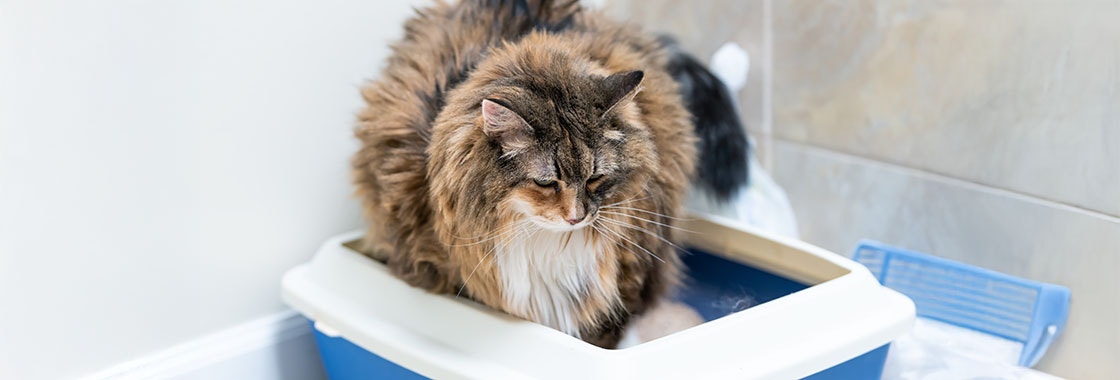How to Make a Constipated Cat Poop


Share
In many households, a cat’s litter routine rarely crosses anyone’s mind, at least until something is out of the ordinary. A companion who strains or avoids the tray is likely dealing with constipation, and the question of how to make a cat poop when constipated can loom large. Ignoring constipation in cats often leads to more than just a bit of discomfort: it can lead to abdominal discomfort, reduced appetite, or worse.
Sometimes dehydration, fur-balls, a change in diet or even a foreign body that has been swallowed can cause trouble; other times, it’s a nutritional issue or lack of movement. Once you spot the signs, a few careful measures can ease the strain. If those don’t help, book an appointment with your vet.
Cat Constipation: Understanding the Basics
Constipation in cats involves hardened stool that refuses to pass easily, leaving them straining for relief. You might see tense posture in the litter tray, small pebble-like droppings, or an overall look of frustration. If left untreated, it can cause abdominal discomfort, a lack of energy, and diminish appetite. Some cats even withdraw or act unsettled when the discomfort grows, so it's important to contact your vet for advice as soon as you notice any signs.
You should address cat constipation sooner rather than later. Why?
- Waste that sits in the bowel too long will become even harder to pass as the colon continues to absorb water from the feces. This can make the cat feel poorly.
- Blockages can worsen, eventually requiring urgent vet intervention.
- Ongoing pain wears on a cat’s mood and trust.
- Early adjustments in diet or hydration are easy and often avert serious trouble later on. Meals built on quality, well-chosen components, and optimum amounts of fibre may help keep things moving before bigger problems begin. That’s why our ingredients are sourced with digestive health in mind.
Symptoms of Constipation in Cats
Cats, in all their mystery, rarely announce their troubles, you may notice the following cat constipation symptoms:
- Prolonged straining: Lingering in the litter tray with little or no stool.
- Hardened droppings: Small, dry lumps if anything emerges at all.
- Lower appetite: A backed-up system often dampens interest in meals. Here, you can read more about what a cat struggling to eat might mean.
- Unusual posture or pacing: Restlessness or hunching may point to discomfort.
- Drop in energy: The effort of pushing can sap their usual spark.
- Vocalizing or abdominal tension: Your cat may cry out or appear tense while trying to pass stool.
Early detection goes a long way. Spotting the signs early gives you a better chance to step in gently and figure out how to make a cat poop when constipated before it turns into something more complicated. Ensuring your cat has a healthy gut and optimum nutrition will help avoid constipation and help ensure that your cat stays active, curious, and happy.
Learn more about cat care to help keep your feline feeling their best.
Causes of Constipation in Cats
Cat constipation doesn’t appear out of nowhere. Often, it builds quietly, fed by small daily habits or things we don’t see until they add up.
Cats who eat mostly dry food but aren’t natural drinkers often end up lacking the moisture needed to keep things moving. Diets that miss the mark, have too little fibre, or sometimes too much, can throw off their internal rhythm. Some cats carry extra fur from grooming, and without help passing it through, it builds up inside. This condition is known as 'Furballs'; cats have tiny hooks on their tongues which aid grooming, but particularly in long haired cats, enables the cat to swallow the loose hairs that are caught by the tongue during grooming. These hairs accumulate in the stomach and are either vomited up as a fur ball, or pass through the intestines and may cause constipation. Supplements and treatments for furballs are readily available, ask your vet for a recommendation.
A quiet lifestyle can play a role too; movement helps the gut, and cats who spend their days lounging may simply not get enough stimulation. There are also deeper issues: aching joints, chronic dehydration, or undiagnosed conditions like kidney disease, which can slow the system down.
Cat Constipation Treatment
If you’re unsure how to make a cat poop when constipated, know that the answer isn’t always complicated. Often, small changes can ease cat constipation symptoms naturally:
- Switch to wet food: Moisture helps soften stool. If your cat normally eats dry, try replacing a few meals with high-quality wet food. You can also mix in a splash of warm water.
- Encourage drinking: Place water bowls in quiet spots around your home and keep them fresh. Some cats prefer running water, so a pet fountain can work wonders.
- Play more often: Physical activity stimulates the gut. Even short daily play sessions: chasing a ping pong ball, or batting a ball, can get things moving.
- Brush regularly: Less hair swallowed means less buildup in the digestive tract.
These small changes, when done patiently and consistently, can often be all it takes if you’re figuring out how to make a cat poop when constipated at home. If their symptoms persist or worsen, immediately stop home care and consult your vet.
When to Contact Your Vet
There comes a point when waiting no longer helps. If your cat hasn’t passed stool in more than two days or shows signs of real distress, such as crying out in the litter box, straining without result, or losing interest in food, it’s time to get help.
Some cats will vomit or appear bloated when suffering with constipation. Others might hide more than usual or become uncharacteristically withdrawn. These are all signs the problem is moving beyond the scope of regular home care. While gentle changes to food and hydration can help in mild cases, they will never substitute for medical attention.
A vet can check for underlying causes and use professional methods and tools. When home care hasn’t helped and you’re still unsure how to make a cat poop when constipated, getting your vet involved is the kindest step forward.
Constipated Cats FAQs
How do you unblock a cat’s bowels?
If a cat’s constipation doesn’t improve at home, a vet can safely clear blockages with minimal stress. They might:
- Give fluids: Rehydrating to help soften the stool.
- Use a safe enema: Formulated for cats, it loosens impacted waste.
- Prescribe a stool softener: Vet-approved options like lactulose help draw moisture into the colon.
- Remove stool manually: Gently extracting hardened waste under sedation
- Investigate the cause: Address dietary, hydration, or health issues to prevent recurrence.
These steps are clinical for a reason; they should never be attempted at home.
Will a constipated cat eventually poop?
Sometimes, yes, but waiting isn’t a great plan. The longer waste stays inside, the drier and harder it gets, making it even tougher to pass. In more stubborn cases, constipation in cats can lead to a serious blockage that won’t clear on its own. If your cat hasn’t pooped in over a day and seems off in any way, it’s best to act fast. A bit of help early on is far better than a big problem later.
How do you help a constipated cat?
If your feline friend is showing early cat constipation symptoms, there are a few things you can try at home to help them along:
- Switch to wet food: It adds moisture and can soften stool.
- Add a little water to their meals or place more water bowls around the house.
- Get them moving: Even short play sessions can help stimulate digestion.
- Brush regularly: Less swallowed fur means less risk of blockage.
Keep changes cautious and slow. If nothing changes after a day or two, or your cat seems unwell, it’s time to pay your vet a visit.
How do cats act when constipated?
Knowing how to make a cat poop when constipated often starts with spotting the right clues. A constipated cat will behave a little differently: quieter, less playful, sometimes a bit withdrawn. You might see them spending longer in the litter tray than usual, straining without much success.
Some felines pace or go back and forth, clearly uncomfortable but unsure of what to do. If they do manage to pass something, it’s often small and dry. Appetite may dip, and they might shy away from touch, especially around the abdomen. Grooming may take a backseat, or they might fixate on certain spots.



